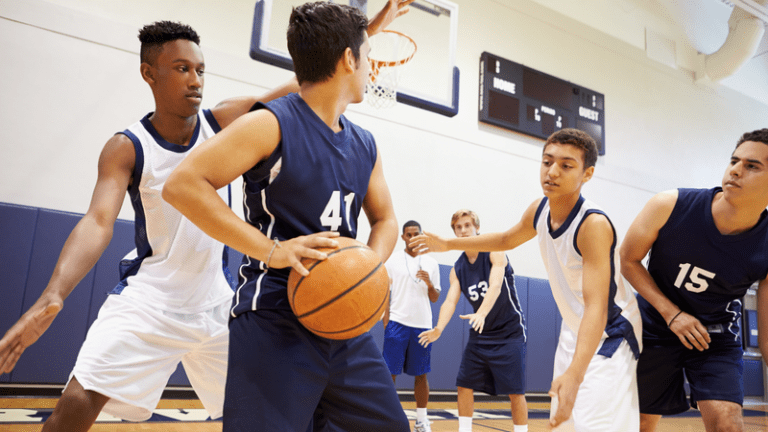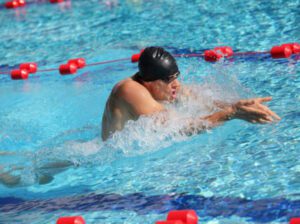What is the Pick and Roll?
– An offensive player sets a screen for another offensive player who currently has the ball. This is also known as a ball screen (The Pick).
– The offensive player dribbles around the ball screen and looks to score.
– The screener, opens up to the ball, and cuts to the basket (The Roll).
1. Dribbler Creates Separation
The first step for an effective pick and roll is for the dribbler to create separation between themselves and the on-ball defender. This sets up the on-ball defender to be screened effectively.
If the on-ball defender is too close, then it will be easy for them to lock on and trail over the screen without being put at too much of a disadvantage. To create this separation, the dribbler should sweep through or jab step if they haven’t used their dribble. If they are in the process of dribbling, a quick jab and crossover or inside-out dribble will be enough to make the on-ball defender take a step back in preparation to defend the drive.
2. Screener Creates Separation
The second step to an effective pick and roll is for the screener to create as much separation as possible between themselves and their defender before setting the on-ball screen.
By creating separation before setting the screen, we decrease the screener’s defender’s ability to provide help on the dribbler. Without good help, the dribbler is often open for the shot or will be attacking a defender who is still closing out to the basketball.
3. Correct Screening Angle
The angle that the screen is set on is arguably the most important part of the pick and roll yet is often overlooked by most coaches.
If you take anything at all from this article, let it be that you focus more on the angle your players are setting on-ball screens. It’s one of those small details that can lead to big results on the court.
4. Screener Makes Contact
The final part of preparing for the pick and roll is for the screener to make contact when setting the screen.
This requires them to hunt out the on-ball defender, focus on the correct angle, and then make contact as they set a strong screen. As this screen is set, 100% focus should be on setting a solid screen. I see far too many players set weak screens as they’re too focused on rolling quickly and getting the basketball.
The reason making contact is beneficial when performing the pick and roll is that it leaves no room for the defender to maneuver around the screen.
If the screen is set a step off and there’s extra space, it’s far easier for the on-ball defender to drop their shoulders and beat the stationary screen. This rule also prevents young players from setting a screen on an area instead of seeking out one of the defenders which can be a big problem for young teams.
5. Dribbler Attacks Off the Screen
Once the screen has been set correctly, it’s now up to the dribbler to read the defense and use the screen.
When dribbling off the screen, the dribbler must drive by the screener shoulder-to-shoulder and use at least two dribbles to create separation and see how the defense reacts. The dribbler must have an attacking mindset! While we don’t expect the dribbler to drive and shoot every time they use a screen, it’s important to attack as it will force the defense to rotate and open up other offensive players.
6. Screener Rolls to the Rim
Once the on-ball defender has fought past the stationary screen, the screener must then cut to the rim looking to catch a pass and score inside.
While it’s up for debate which one is more effective, here are the two ways that the screener can cut to the rim:
- Reverse Pivot and Roll – This involves the screener sealing off the on-ball defender by reverse pivoting using the foot closest to the rim as the pivot foot.
- Dive to the Rim – The other option is for the screener to immediately dive to the rim without reverse pivoting.
7. Dribbler Makes Best Decision
The final step of the pick and roll is for the dribbler to read the defense and make the correct decision.
This could be to attack the rim, pass to the roll player, or dribble in and kick the basketball out to the outside shooters or players cutting to the rim.
Note: The ball-handler must be aware of their teammate’s abilities since this will determine whether they make a good decision. For example, it’s much better to pass to a shooter on the perimeter than a player who struggles from long range.
CoachUp is the safest and easiest way to find a coach for personalized training. With our 100% money-back guarantee and vetted coaches, anyone can achieve their full athletic potential. Find your perfect coach today and become the athlete you want to be!
How useful was this post?
Click on a star to rate it!
Average rating 4.5 / 5. Vote count: 2
No votes so far! Be the first to rate this post.



